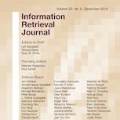Recently, the emergence of large language models (LLMs) has revolutionized the paradigm of information retrieval (IR) applications, especially in web search. With their remarkable capabilities in generating human-like texts, LLMs have created enormous texts on the Internet. As a result, IR systems in the LLMs era are facing a new challenge: the indexed documents now are not only written by human beings but also automatically generated by the LLMs. How these LLM-generated documents influence the IR systems is a pressing and still unexplored question. In this work, we conduct a quantitative evaluation of different IR models in scenarios where both human-written and LLM-generated texts are involved. Surprisingly, our findings indicate that neural retrieval models tend to rank LLM-generated documents higher.We refer to this category of biases in neural retrieval models towards the LLM-generated text as the \textbf{source bias}. Moreover, we discover that this bias is not confined to the first-stage neural retrievers, but extends to the second-stage neural re-rankers. Then, we provide an in-depth analysis from the perspective of text compression and observe that neural models can better understand the semantic information of LLM-generated text, which is further substantiated by our theoretical analysis.We also discuss the potential server concerns stemming from the observed source bias and hope our findings can serve as a critical wake-up call to the IR community and beyond. To facilitate future explorations of IR in the LLM era, the constructed two new benchmarks and codes will later be available at \url{https://github.com/KID-22/LLM4IR-Bias}.
翻译:暂无翻译





